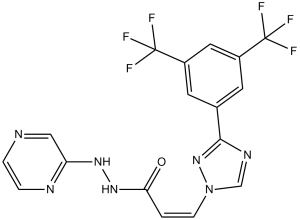Selinexor (KPT-330)
This product is for research use only, not for human use. We do not sell to patients.

For small sizes, please check our retail website as below: www.invivochem.com
| Size | Price | Stock |
|---|---|---|
| 50mg | $250 | To Be Confirmed |
| 100mg | $430 | To Be Confirmed |
| 200mg | $645 | To Be Confirmed |
Cat #: V1589 CAS #: 1393477-72-9 Purity ≥ 98%
Description: This product has been discontinued. Selinexor (also known as KPT-330) is an orally bioavailable, potent and selective CRM1 inhibitor.
Top Publications Citing Invivochem Products
Publications Citing InvivoChem Products
Product Promise

- Physicochemical and Storage Information
- Protocol
- Related Biological Data
- Stock Solution Preparation
- Quality Control Documentation
| Molecular Weight (MW) | 443.31 |
|---|---|
| Molecular Formula | C17H11F6N7O |
| CAS No. | 1393477-72-9 |
| Storage | -20℃ for 3 years in powder formr |
| -80℃ for 2 years in solvent | |
| Solubility In Vitro | DMSO: 89 mg/mL (200.8 mM)r |
| Water: <1 mg/mLr | |
| Ethanol: 40 mg/mL (90.2 mM) | |
| Solubility In Vivo | 2% DMSO+49% PEG 300+dd H2O: 5mg/mL |
| Synonyms | KPT-330; KPT 330; KPT330 Chemical Name: (Z)-3-(3-(3,5-bis(trifluoromethyl)phenyl)-1H-1,2,4-triazol-1-yl)-N'-(pyrazin-2-yl)acrylohydrazide SMILES Code: O=C(NNC1=NC=CN=C1)/C=CN2N=C(C3=CC(C(F)(F)F)=CC(C(F)(F)F)=C3)N=C2 Exact Mass: 443.09293 |
| Protocol | In Vitro | To determine whether the nuclear export protein XPO1 provides a target for radiosensitization, the effects of clinically relevant XPO1 inhibitor selinexor on the radiosensitivity of glioblastoma cells were evaluated. As determined by clonogenic survival analysis, selinexor enhanced the radiosensitivity of GSCs but not normal fibroblast cell lines. On the basis of γH2AX foci and neutral comet analyses, selinexor inhibited the repair of radiation-induced DNA double-strand breaks in GSCs, suggesting that the selinexor-induced radiosensitization is mediated by an inhibition of DNA repair. Consistent with a role for XPO1 in the nuclear to cytoplasm export of rRNA, selinexor reduced 5S and 18S rRNA nuclear export in GSCs, which was accompanied by a decrease in gene translation efficiency, as determined from polysome profiles, as well as in protein synthesis. In contrast, rRNA nuclear export and protein synthesis were not reduced in normal cells treated with selinexor. |
|---|---|---|
| In Vivo | To evaluate the potential of Selinexor to enhance GBM radiosensitivity under in vivo conditions, mice bearing NSC11 brain tumors (40 days post-implantation) were treated with a single dose of Selinexor (20mg/kg); tumors were collected at times out to 48h and polysome profiles generated from individual tumors. Representative profiles are shown in figure 6A along with the (translational efficiencies) TEs (mean ± SEM) generated from 3 mice. As reflected by the reduction in polysome fraction, TE was decreased by 1h after Selinexor administration reaching a maximum reduction by approximately 24h, which appeared to begin to recover towards untreated levels at 48h. These results indicate that Selinexor penetrates the blood-brain barrier and suggests that it targets the same processes within the tumor as detected in vitro. Based on the time course of the TE decrease, a protocol was designed to test the antitumor effectiveness the Selinexor/radiation combination. Selinexor treatment of mice alone had no significant effect on survival as compared to vehicle; radiation alone resulted in a significant increase in survival (Figure 6B). The survival of mice receiving the combination protocol was significantly increased as compared with control and, importantly, as compared with radiation alone. Whereas the median survival after Selinexor was not significantly different from vehicle, radiation alone increased median survival by 9 days and the combination by 18 days versus vehicle, indicating that the combination protocol increased tumor radiosensitivity with an apparent DEF of 2. Thus, these data suggest that Selinexor inhibits gene translation in orthotopic brain tumors and enhances their radiosensitivity. |
These protocols are for reference only. InvivoChem does not
independently validate these methods.
| Solvent volume to be added | Mass (the weight of a compound) | |||
|---|---|---|---|---|
| Mother liquor concentration | 1mg | 5mg | 10mg | 20mg |
| 1mM | 2.2558 mL | 11.2788 mL | 22.5576 mL | 45.1152 mL |
| 5mM | 0.4512 mL | 2.2558 mL | 4.5115 mL | 9.0230 mL |
| 10mM | 0.2256 mL | 1.1279 mL | 2.2558 mL | 4.5115 mL |
| 20mM | 0.1128 mL | 0.5639 mL | 1.1279 mL | 2.2558 mL |
The molarity calculator equation
Mass(g) = Concentration(mol/L) × Volume(L) × Molecular Weight(g/mol)
Mass
=
Concentration
×
Volume
×
Molecular Weight*
The dilution calculator equation
Concentration(start)
×
Volume(start)
=
Concentration(final)
×
Volume(final)
This equation is commonly abbreviated as: C1 V1 = C2 V2
Concentration(start)
C1
×
Volume(start)
V1
=
Concentration(final)
C2
×
Volume(final)
V2
Step One: Enter information below
Dosage mg/kg
Average weight of animals g
Dosing volume per animal µL
Number of animals
Step Two: Enter the in vivo formulation
%DMSO
+
%
+
%Tween 80
+
%ddH2O
Calculation Results:
Working concentration:
mg/ml;
Method for preparing DMSO master liquid:
mg
drug pre-dissolved in
µL
DMSO(Master liquid concentration
mg/mL)
,Please contact us first if the concentration exceeds the DMSO solubility of the batch of drug.
Method for preparing in vivo formulation:
Take
µL
DMSO master liquid, next add
µL
PEG300, mix and clarify, next add
µL
Tween 80,mix and clarify, next add
µL
ddH2O,mix and clarify.
Note:
- (1) Please be sure that the solution is clear before the addition of next solvent. Dissolution methods like vortex, ultrasound or warming and heat may be used to aid dissolving.
- (2) Be sure to add the solvent(s) in order.




































